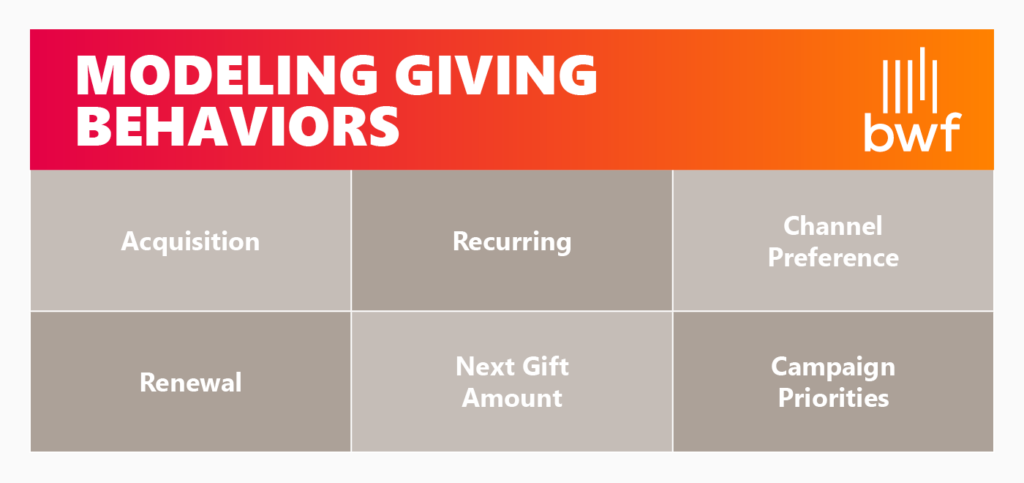
On its face, donor retention may seem like a simple metric. It’s a measurement of how many donors gave to your organization again this year after contributing the previous year.
However, several complex factors go into a donor’s decision to give to your organization regularly. How they feel about your organization’s reliability, their relationship to your mission, and the ongoing stewardship efforts they receive from your nonprofit all play a role in their choice.
This guide pulls insights from BWF’s donor experience survey and research from renowned philanthropy academic Adrian Sargeant to present tried-and-true best practices for increasing your donor retention rate.
1. Show donors they can trust you with their gifts.
According to BWF’s donor experience survey, in higher education fundraising, donors rank “Ensuring gifts are disbursed to the university as [they] have directed” as the #1 most important task of a fundraising development team. The level of trust donors have in your organization is a major determinant of how likely they are to keep giving.
Increase transparency and accountability by taking these steps:
- Respect donors’ wishes. When donors contribute restricted gifts to your nonprofit, ensure you only use these donations as supporters intended. Misusing these gifts leaves your nonprofit vulnerable to legal action and erodes trust.
- Demonstrate how you’ve used donors’ gifts wisely to make a tangible positive impact on your mission. Share data-driven stories about how donations help those in need. Send emails with relevant statistics, case studies, and testimonials from beneficiaries.
- Show donors why you need their ongoing support. Sargeant’s research (referenced in the introduction) shows that the most common reason donors stop giving is because they feel that other causes are more deserving of their support. Your donor outreach should outline the reasons why your organization requires ongoing support. For example, demonstrate how your monthly giving program helps keep your volunteer program stocked with the supplies volunteers need to be successful.
Lean into personal, human connections in your storytelling. Donors will be more likely to give again when they feel like they have an emotional attachment to your cause based on trust. Share direct quotes, videos, and photos of beneficiaries to help donors feel connected to the individuals being supported by charitable gifts.
2. Send timely, descriptive thank-you messages.
Sargeant’s research shows that the second most common reason donors give for ceasing their support is because they weren’t acknowledged for their gifts. This is a huge missed opportunity for many organizations, especially considering it’s never been easier to send prompt, descriptive donor thank-you messages.
Use your donor management system or CRM to track donations and automatically update donors’ profiles with new gift information and contact information. Then, through email integrations, you can automatically send thank-you emails to acknowledge donors’ gifts and show appreciation.
Consider the following best practices when developing your thank-you message strategy:
- Send thank-you emails within 24 hours of receiving the gift. These messages should include a donation receipt and a heartfelt thank-you message from a leader at your organization.
- Personalize the messages with each donor’s name and gift amount. Use your CRM to automatically populate thank-you emails with donors’ names, gift dates, and gift amounts. For example, you could say “Dear Jay, we can’t thank you enough for your generous $100 gift on May 27. Because of your support, more students will have access to standardized test prep books to support their educational goals.”
- Follow up with a more in-depth thank-you letter. Within a month of a donor’s gift, send a more detailed letter with data about how the donation made a difference and photos depicting beneficiaries. Send this letter to donors’ home addresses to provide a unique touchpoint. Consider adding extra perks like stickers or a magnet branded to your organization to show your gratitude.
As you get to know donors over time, note their preferences for how they like to be thanked for donations. For example, some donors may open your emails more frequently, while others prefer receiving a physical letter. Some major donors may like public recognition in the form of naming rights or prominent mentions in your annual report, while others prefer to remain anonymous. Keep track of these preferences in each supporter’s profile to provide a better donor experience.
3. Use predictive modeling to identify upgrade opportunities.
Predictive modeling can help you determine which donors are most likely to renew or upgrade their giving. This process involves inputting donor data into predictive analytics tools and modeling future likely behaviors based on patterns and trends.
According to BWF’s fundraising predictive analytics guide, you can use predictive modeling to anticipate:

- New donor acquisition
- Recurring giving
- Communication channel preferences
- Renewal likelihood
- Next gift amount
- Giving priorities (such as the specific campaign, project, or program donors are likely to support)
With predictive solutions, you can pinpoint potential donors hiding in plain sight who have the capacity and willingness to renew or upgrade their giving amounts. Then, you can reach out to them using their preferred platforms and request a gift amount that aligns with their ability and level of commitment to your cause. Donors will be much more receptive to a request that aligns with their giving capacity and is sent using outreach methods that resonate with them.
4. Make donors feel part of your community.
Donors like to feel part of a worthy cause that’s bigger than themselves. By welcoming them to your organization’s larger community, you can form stronger personal bonds with supporters. They’ll be much more likely to continue giving when they have a personal connection with not just your mission, but your organization itself.
Foster a stronger sense of community with the help of these best practices:
- Offer technical support as needed. Provide support for donors who are figuring out which donation option is best for them or need help managing your online giving platform. Offer an email address or online chat feature that donors can use to ask questions and get clarification on the giving process.
- Provide multiple ways to engage with your mission. Donating is just one piece of the puzzle when it comes to ways supporters can engage with your cause. Highlight other mission-critical opportunities like volunteering, advocacy, and peer-to-peer fundraising. Donors can choose additional ways to get involved that align with their availability, skills, and interests, further strengthening their ties to your organization.
- Ask for feedback. Send surveys, hold in-person meetings, and call donors up to ask for their feedback. Request input on everything from your donation process to your communication frequency, marketing messages, and other stewardship efforts. Be sure to let donors know the changes you plan to make based on their feedback so they know their insights made a difference.
You can even facilitate social opportunities like meetups and networking events so donors have the opportunity to get to know their fellow supporters on a personal level.
On the other hand, some supporters may prefer taking a laid-back approach to their involvement with your mission. Present those supporters with opportunities like monthly giving, where they can set their donation amount and not have to worry about inputting their payment information over and over again.
5. Don’t be afraid to ask for another gift.
As Sargent’s donor experience research shows, donors often stop giving because they weren’t prompted to give again, or they forgot they ever gave in the first place. That underscores the importance of proactively reminding donors of their impact and asking for additional gifts.
Keep these guidelines in mind when asking for additional donations:
- Don’t wait too long to request an additional gift. If you wait too long to ask for another donation, supporters may forget they gave to your organization or move on to supporting other organizations they feel are more worthy. Use each donor’s gift amount as an indication of when to ask for another contribution. For example, you may wait until the following year to ask for another gift from a major donor who contributed $10,000. However, you might wait two months before asking a donor who gave $50 for another donation. Use your best judgment to determine the right time to ask each supporter, but don’t delay for fear of disengagement.
- Ask for gifts using donors’ preferred platform, whether online, in an in-person meeting, or using direct mail. Sending a message on each donor’s favorite communication channel increases the likelihood that they’ll see your request.
- Request a specific donation amount so donors know exactly what kind of gift you’re looking for. Use predictive modeling and prospect research to choose an appropriate amount based on donors’ past gifts and giving potential.
Donors should understand your organization’s urgent and ongoing need for their support. Show them their support makes a crucial difference by keeping them in the loop with your fundraising efforts.
Ultimately, improving your donor retention strategy requires your organization to view donors as more than just monetary contributors. You must take a holistic view of your donors by inviting them to engage with your cause as true collaborators. By providing impact information, engaging donors in other mission-critical activities, and showing them the critical role they play in the fundraising process, you can retain more donors over the long term.

James Barnard, Associate Managing Vice President of Annual Giving and Digital Marketing at BWF
James an integral part of the team at the global fundraising consultancy BWF. He helps nonprofit clients develop digital strategies for fundraising and marketing. James has been active in CASE for a number of years, participating as a conference speaker and CASE District II board member.
